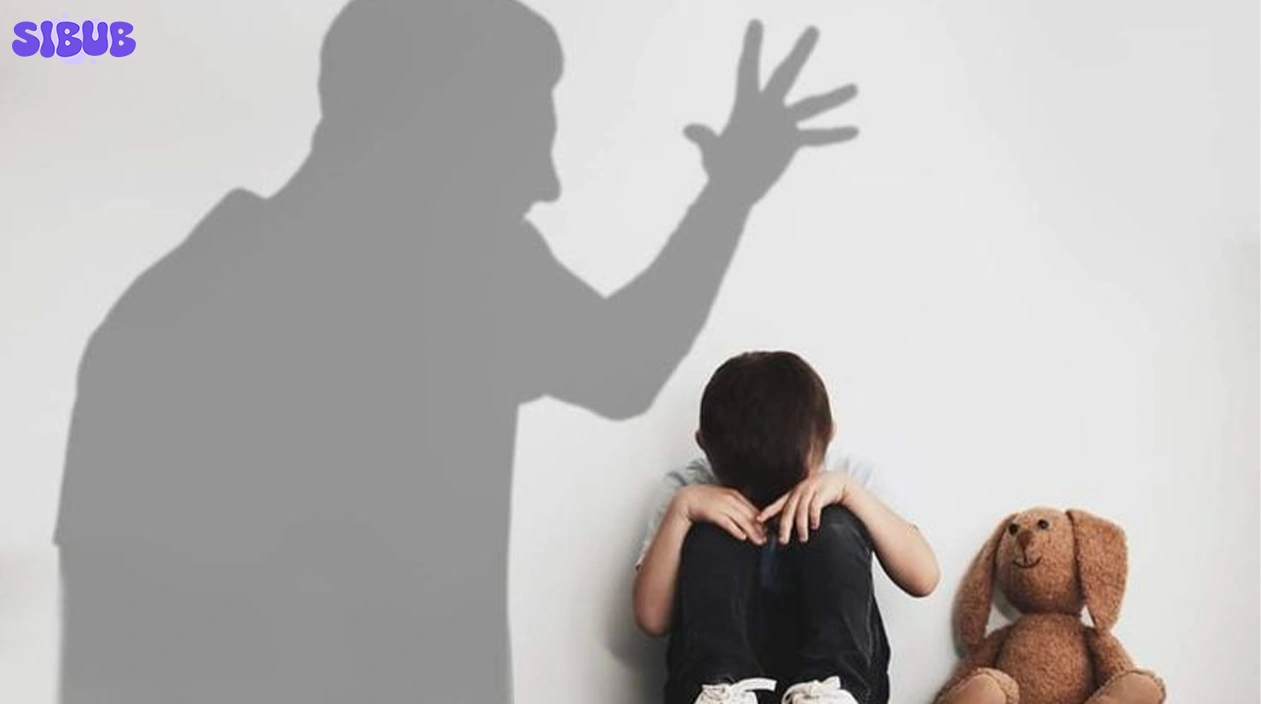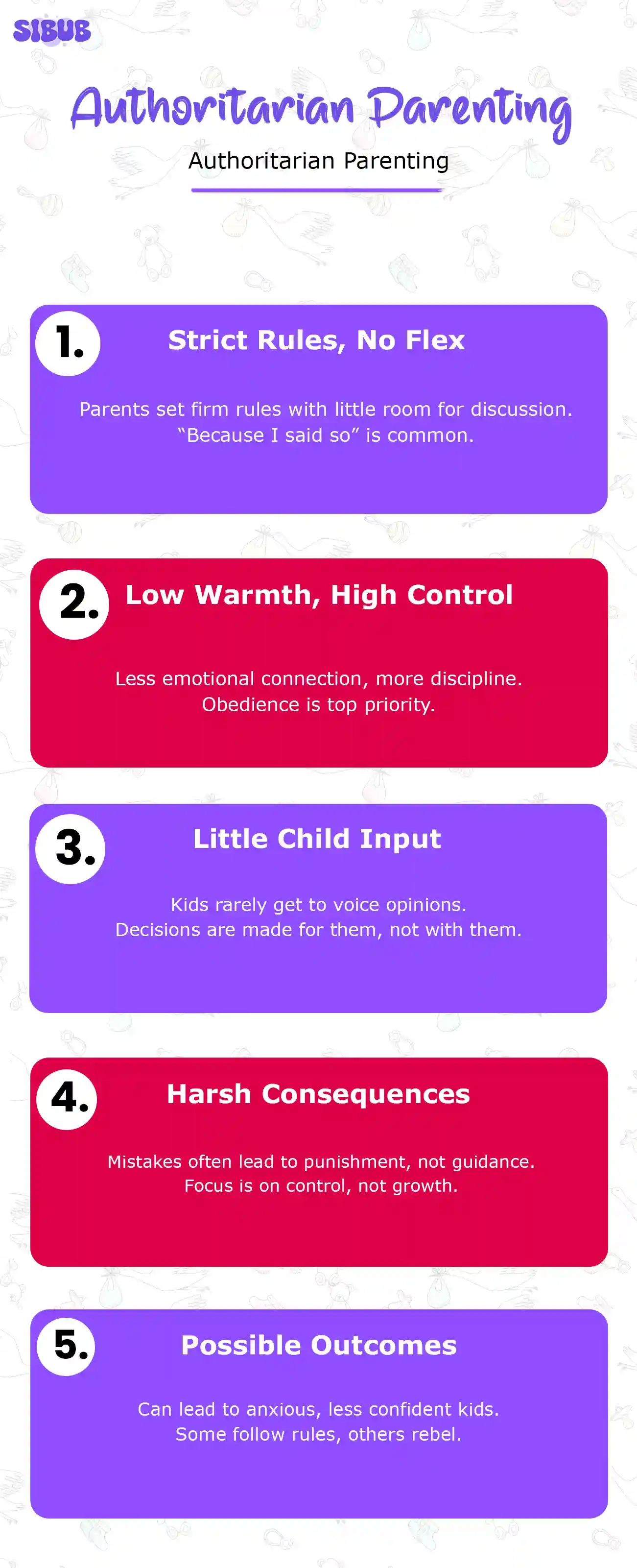When we talk about raising kids, not every parent follows the same playbook. Some let their kids explore with freedom. Others take a much firmer approach. One of the most well-known parenting styles is the authoritarian parenting style.
In this blog, we’ll define authoritarian parenting style, explore authoritarian parenting examples, and take a look at the authoritarian style in everyday family life.
If you’re wondering what is authoritarian style or looking for a real-life example of authoritarian parenting, keep reading…
What is the Authoritarian Parenting Style?
To define authoritarian parenting style, imagine a parent who runs the household like a strict boss. In this style, rules are non-negotiable, punishments are common, and obedience is expected without question.
These parents believe that children should be seen, not heard. They don’t often explain the “why” behind rules. Instead, it’s all about structure, discipline, and high expectations. Mistakes are not usually treated as learning opportunities, they’re often met with punishment.

Visit: Authoritative Parenting Style: A Complete Guide
Key Traits of the Authoritarian Style
Here are some common signs that a parent uses the authoritarian parenting style:
- Strict rules with little room for discussion
- Punishments rather than discipline
- High expectations for behavior and achievement
- Low warmth or emotional support
- Little communication between parent and child
These parents rarely ask for their child’s opinion. It’s usually a one-way street when it comes to decision-making.
Authoritarian Parenting Style Examples
Let’s look at some authoritarian parenting examples to get a clearer picture.
1. No Room for Discussion
A child asks why their bedtime is at 8 PM. The parent responds with, “Because I said so.” There’s no explanation, no flexibility, and no chance for the child to express their thoughts. This is a classic example of authoritarian parenting.
2. Harsh Punishment for Mistakes
If a child gets a B on a math test, the parent might take away their phone for a week instead of helping them study. Again, the focus is on discipline rather than support.
3. Obedience is Everything
An example of an authoritarian parent might be someone who demands their child dress a certain way, eat specific meals, or participate in certain activities, without asking what the child wants. Disagreeing is seen as disrespectful.

How the Authoritarian Parenting Style Affects Children
Children raised under the authoritarian parenting style often grow up in a tightly controlled environment. While some may appear obedient and well-behaved, the long-term effects can be more complex.
Discover: Pomodoro Study Method – Boost Focus in Kids with ADHD
Possible Outcomes:
- Low self-esteem: Constant control may make children feel like they can’t make decisions on their own.
- Aggressive behavior: They might act out when away from authority figures.
- Difficulty in social settings: Shyness or fear of speaking up can develop.
- Rebellion in teenage years: Overly strict rules often lead to pushback as kids get older.
Some children might also struggle with anger. They haven’t been taught how to manage strong emotions because punishment took the place of emotional guidance.
Why Do Some Parents Use This Style?
Many parents follow the authoritarian style because that’s how they were raised. In some cultures, this style is the norm. Parents may believe it builds discipline, respect, and success. And in some ways, it can, especially in structured settings like school or sports.
But when taken too far, it can backfire. Children may grow resentful or emotionally distant. That’s why it’s important to find a balance between rules and relationships.

How is Authoritarian Parenting Different From Other Styles?
Psychologists usually group parenting into four main categories:
- Authoritarian
- Authoritative
- Permissive
- Uninvolved
Here’s how the authoritarian parenting style stacks up:
StyleRulesWarmthCommunicationDisciplineAuthoritarianHighLowLowHarshAuthoritativeHighHighHighSupportivePermissiveLowHighHighRareUninvolvedLowLowLowInconsistent
Out of all four, authoritative parenting is often seen as the most balanced. But the authoritarian style still has a strong presence in many households.
Explore: ADHD Treatment For Kids: Finding The Right Medication
Cultural Views on Authoritarian Parenting
It’s important to understand that culture plays a big role in parenting styles. In some communities, being strict is seen as loving. High expectations and discipline are viewed as ways to help children succeed.
For instance, some immigrant families use the authoritarian parenting style to keep children focused on school and away from bad influences. Their goal is to protect their children and prepare them for a better life.
So while authoritarian parenting style examples may look overly strict in one culture, they can be considered normal, or even ideal, in another.
Is Authoritarian Parenting Ever a Good Thing?
Believe it or not, there can be benefits in certain cases.
Potential Benefits:
- Clear structure and rules give children a sense of security.
- Kids may follow rules better in school or public spaces.
- Some become high achievers due to pressure to succeed.
But here’s the catch: those benefits often come at a cost. Children may struggle emotionally or socially. They might have trouble thinking independently or making decisions without guidance.
How to Shift From Authoritarian to Balanced Parenting
If you recognize some authoritarian parenting style examples in your home and want to change, it’s never too late.
Here are a few tips:
- Talk With Your Child
Start by having open conversations. Explain the rules and listen to their thoughts. This builds trust.
- Use Discipline, Not Punishment
Instead of yelling or grounding, try talking about what went wrong. Help your child learn from mistakes.
- Show Affection
Be warm and supportive. A hug or kind word goes a long way.
- Encourage Independence
Let your child make age-appropriate choices. Let them help set goals and solve problems.
Shifting to a more authoritative approach doesn’t mean giving up structure. It just means balancing discipline with emotional support.
Real-World Example of Authoritarian Parent
Imagine a dad who expects his 10-year-old son to get perfect grades. If the child comes home with an A-minus, he’s grounded. There’s no praise for effort, no talk about what could improve, just punishment.
Now, picture a teacher telling that child to speak up in class. The child stays silent. Why? Because at home, speaking out gets him in trouble. This is a real-life example of authoritarian parenting shaping a child’s confidence.
Learn More: Using OTC Drugs Runny Nose Medicine to Treat Cold
Final Thoughts
The authoritarian parenting style is all about control, rules, and discipline. Some parents feel this is the best way to raise responsible kids. But without emotional support and open communication, it can do more harm than good.
If you’ve ever asked yourself, “What is authoritarian style?”, now you know it’s not just about being strict. It’s about how that strictness affects the heart and mind of a growing child.
Balance is key. You can still set high expectations and boundaries while showing love and respect. It’s not about being perfect, it’s about being present.
Quick Recap
- The authoritarian parenting style is strict, structured, and rule-heavy.
- It involves low emotional warmth and limited communication.
- Authoritarian parenting style examples include punishment over guidance and obedience without discussion.
- Children raised this way may struggle with self-esteem, anger, and social skills.
- Cultural views and personal upbringing shape why some parents choose this path.
- A shift toward authoritative parenting can improve both behavior and relationships.
Want More?
Interested in more posts like this? Check out our parenting section, where we explore how different styles shape childhood, and how to make fun and meaningful memories as a family.
